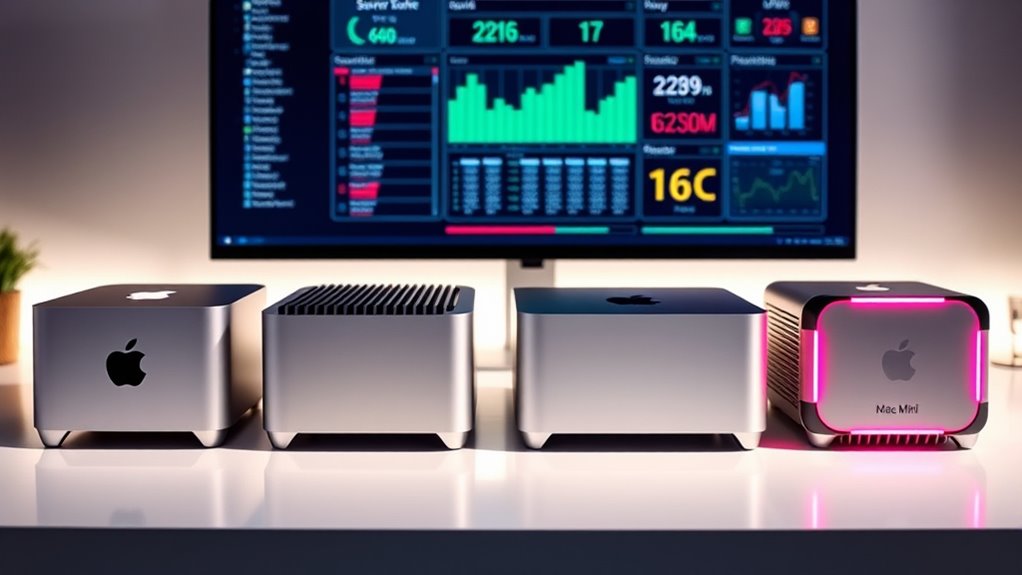If you’re looking for the best Mac minis for a media server in 2025, I recommend models with the latest M4 or M4 Pro chips. They offer powerful performance, seamless ecosystem integration, and various storage options. Their compact size and quiet operation make them ideal for space-efficient setups. I’ll guide you through the top choices and key features to weigh up, so you can choose the perfect media hub for your needs. Keep going to learn more.
Key Takeaways
- Prioritize models with the M4 chip for fast media processing and hardware acceleration.
- Opt for configurations with at least 16GB RAM and ample internal storage for seamless media management.
- Ensure multiple Thunderbolt 4, HDMI, and Ethernet ports for extensive connectivity and device integration.
- Choose compact, cool-running designs suitable for continuous operation in space-constrained setups.
- Balance price, performance, and future-proof features to maximize media server value in 2025.
Apple 2024 Mac mini Desktop Computer with M4 Chip
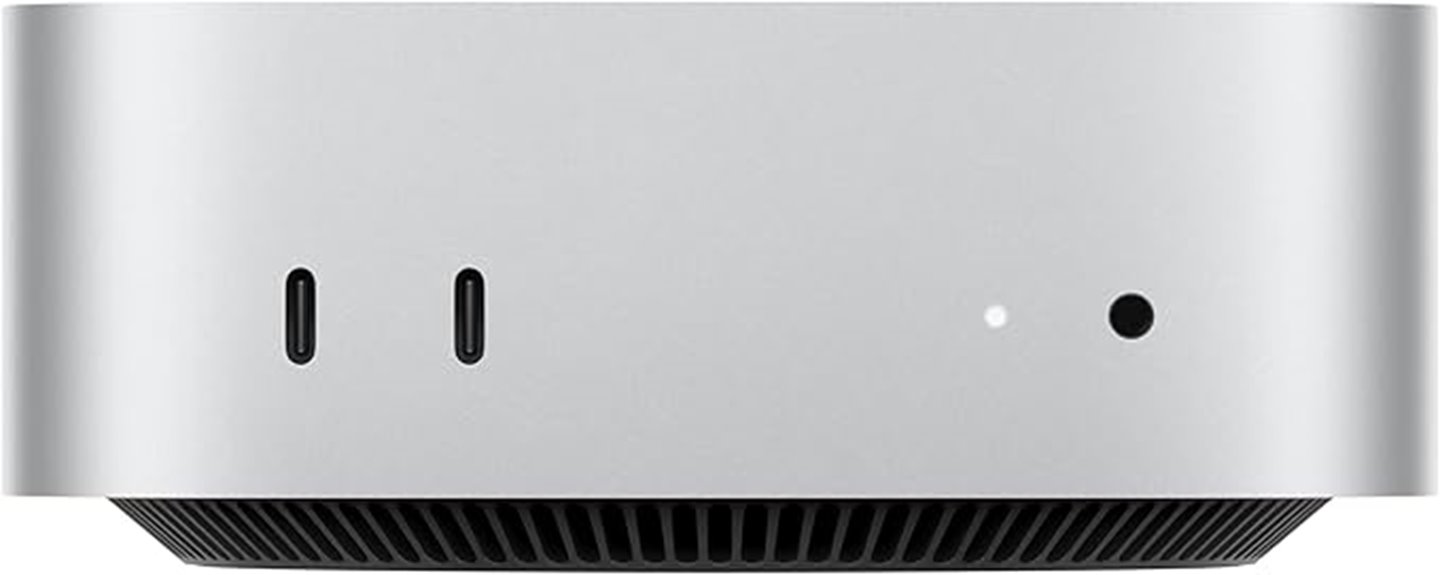
If you’re looking for a compact yet powerful Mac Mini for media server use, the Apple 2024 Mac mini with M4 chip is an excellent choice. Its tiny five-by-five-inch design fits easily next to your monitor and offers impressive performance thanks to the 10-core M4 processor, 16-core Neural Engine, and up to 32GB of memory. It handles media encoding, multitasking, and data transfers smoothly while running cool and quiet. With multiple Thunderbolt, USB-C, HDMI, and Ethernet options, it supports up to three displays. Its build quality feels premium, and it integrates seamlessly with macOS and other Apple devices, making it ideal for media serving and creative workflows.
Best For: users seeking a compact, powerful Mac mini ideal for media servers, creative workflows, and multitasking in a space-efficient design.
Pros:
- Small footprint fits easily next to monitors and in tight spaces
- Impressive performance with M4 chip, up to 32GB RAM, and multiple display support
- Runs cool and quiet, suitable for continuous media serving and multitasking
Cons:
- Non-upgradable RAM and storage options may limit future expansion
- External cables and drives recommended for optimal performance and capacity
- Limited ports on the front may require additional hubs for extensive peripheral connectivity
Apple 2024 Mac mini Desktop Computer with M4 Chip
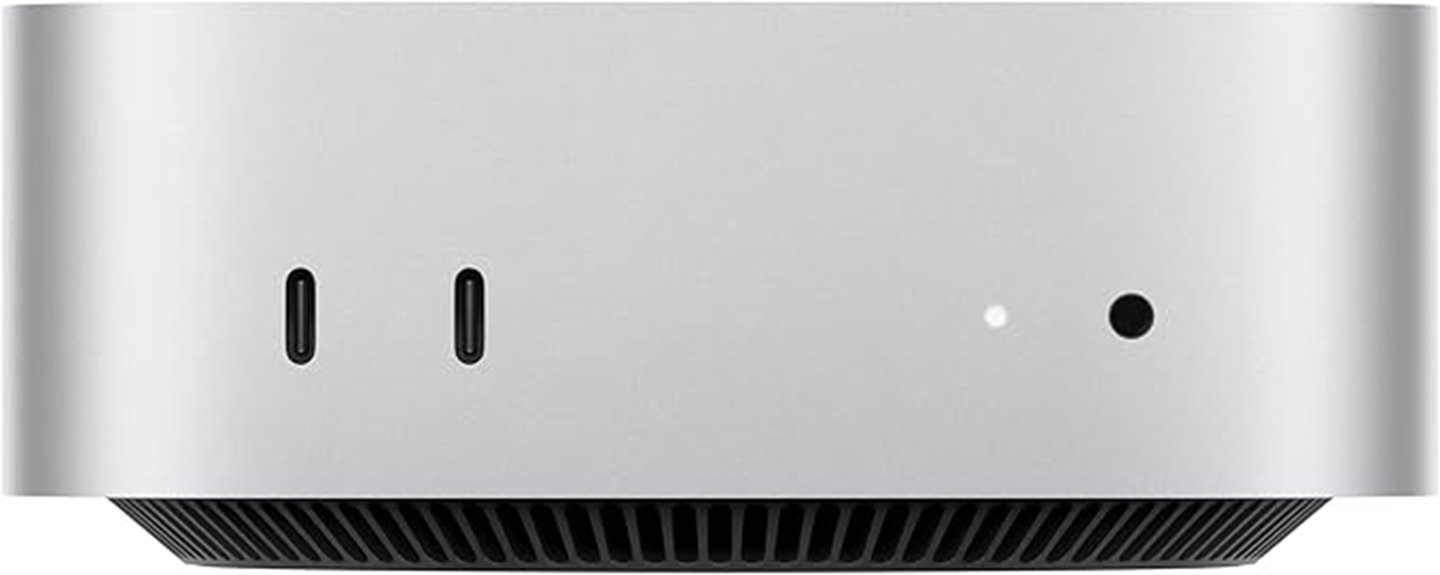
Looking for a compact, yet powerhouse device to serve your media needs? The Apple 2024 Mac mini with M4 chip fits perfectly. Its five-by-five-inch size makes it easy to place next to your monitor or in tight spaces, while weighing just 1.5 pounds for portability. Powered by the M4 chip with a 10-core CPU and GPU, plus 24GB of unified memory, it handles media playback, light editing, and multitasking with ease. Connectivity options include Thunderbolt 4, HDMI, Ethernet, and USB-C ports supporting multiple displays. It’s quiet, cool, and highly responsive, making it an excellent choice for a reliable, space-efficient media server.
Best For: users seeking a compact, powerful desktop for media playback, light editing, and multitasking in space-constrained environments.
Pros:
- Extremely compact and portable design that fits easily next to monitors or in tight spaces
- Powerful M4 chip with 10-core CPU and GPU ensures fast performance for media and multitasking
- Quiet operation with efficient cooling makes it suitable for continuous use without noise
Cons:
- Non-upgradable RAM and storage limits customization after purchase
- Limited to specific ports without additional expansion options for some professional peripherals
- May be overpowered for users with only basic computing needs, potentially making it less cost-effective
Apple 2024 Mac mini Desktop Computer with M4 Pro chip
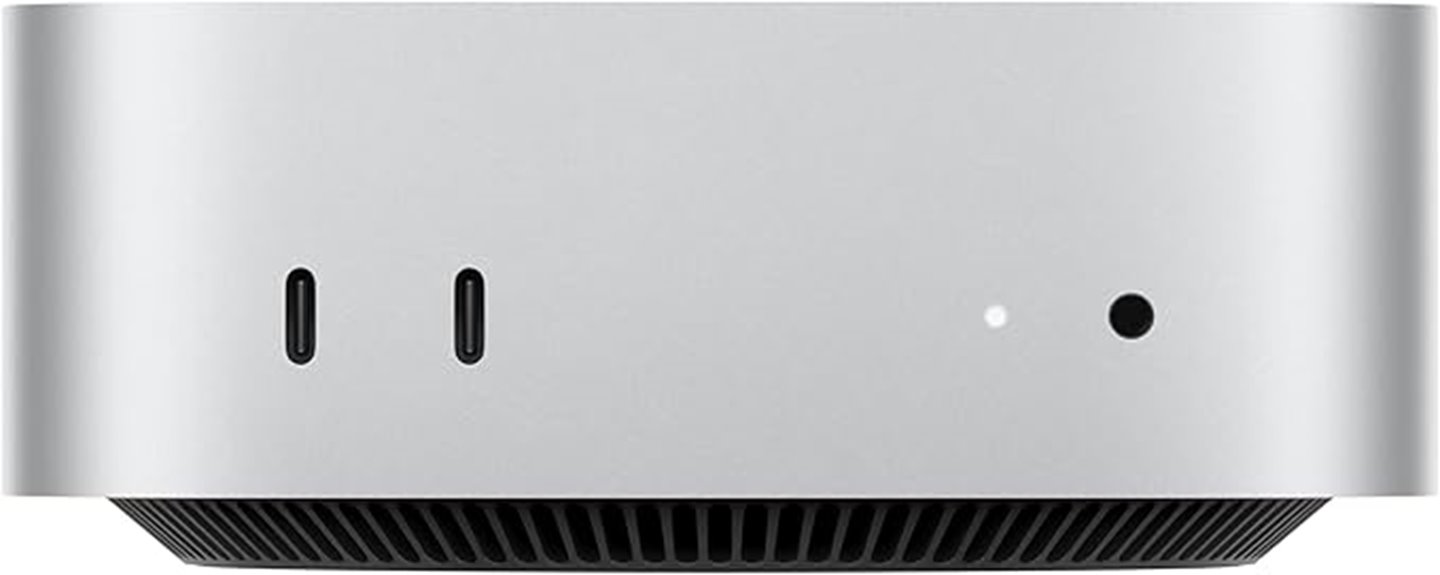
The Apple 2024 Mac mini with M4 Pro chip stands out as an ideal choice for media server enthusiasts who need powerful performance in a compact form. Measuring just 5×5 inches, it fits easily next to monitors or in tight spaces, yet it packs a punch with a 12-core CPU and 16-core GPU. With 24GB of unified memory and a 512GB SSD, it handles demanding tasks like streaming, transcoding, and large file management effortlessly. Its versatile connectivity includes Thunderbolt, HDMI, Gigabit Ethernet, USB-C, and a headphone jack. This mini offers desktop-level power with seamless ecosystem integration, making it perfect for a robust, space-saving media server setup.
Best For: media server enthusiasts seeking a compact, powerful device capable of handling demanding streaming, transcoding, and large file tasks with seamless ecosystem integration.
Pros:
- Compact size with a powerful M4 Pro chip delivers desktop-level performance in a tiny form factor
- Versatile connectivity options including Thunderbolt, HDMI, and Ethernet support complex media workflows
- Seamless integration with Apple ecosystem enhances productivity and user experience
Cons:
- Limited internal storage at 512GB may require external drives for large media libraries
- Higher price point compared to less powerful or larger media server options
- Upgrading internal components post-purchase is not possible due to Apple’s design constraints
Apple 2024 Mac mini Desktop Computer with M4 Chip
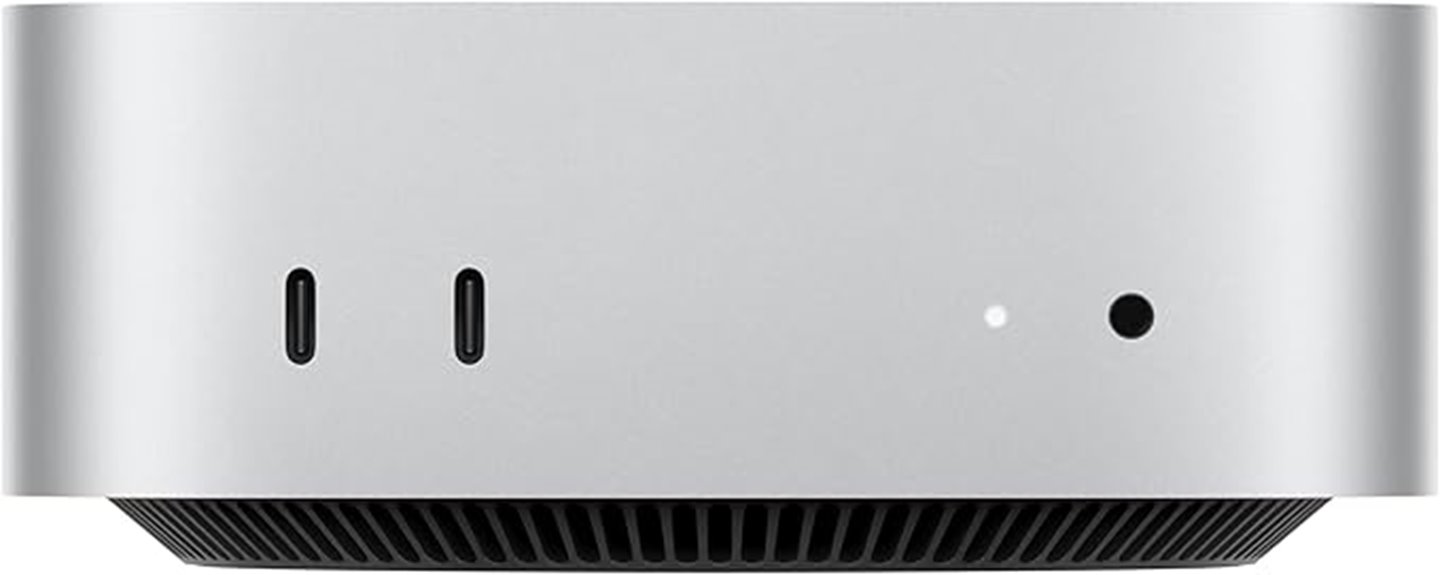
With its compact size and powerful M4 chip, the Apple 2024 Mac mini is an ideal choice for anyone setting up a media server in limited space. Its five-by-five-inch footprint easily fits next to monitors or in tight spots, yet it packs impressive performance with a 10-core CPU, 10-core GPU, and up to 32GB of unified memory. The fast SSD storage and hardware-accelerated media engine handle 4K and 8K media effortlessly. Quiet, cool, and lightweight at 1.5 pounds, it’s perfect for continuous media streaming, editing, or multitasking. Seamlessly integrates with Apple’s ecosystem, supports multiple high-res displays, and offers robust connectivity, making it a versatile, space-efficient media hub.
Best For: users seeking a compact, powerful media server or desktop that seamlessly integrates with Apple’s ecosystem and handles high-resolution media editing and multitasking with ease.
Pros:
- Extremely compact and space-efficient design ideal for limited setups
- High performance with M4 chip, supporting demanding media tasks and multitasking
- Quiet operation with minimal heat generation, suitable for continuous use
Cons:
- Non-upgradable RAM and storage, limiting future expandability
- Limited ports on the front, requiring external hubs for additional connectivity
- Higher price point relative to similar-sized non-Apple alternatives
Factors to Consider When Choosing Mac Mini as a Media Server
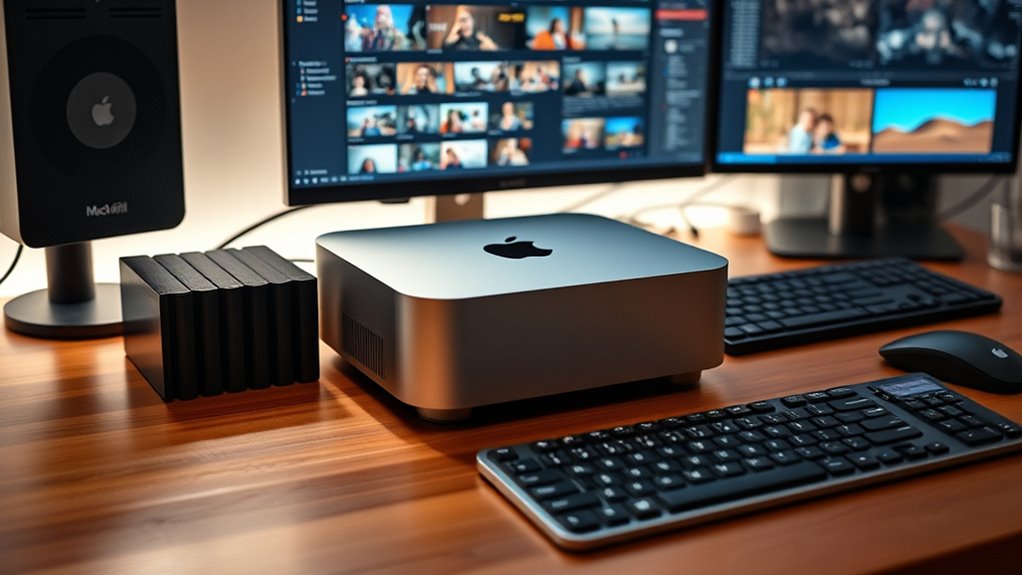
When choosing a Mac Mini for a media server, I consider several key factors to make sure it meets my needs. Things like processing power, storage options, and connectivity are essential, but I also look at compatibility with media apps and how quiet the system runs. These considerations help me pick a model that’s reliable and efficient for my media setup.
Processing Power Needs
Choosing the right Mac Mini for your media server hinges largely on its processing power, as this determines how well it can handle multiple streams, transcoding, and media management simultaneously. A powerful CPU with multiple cores, like a 10-core or 12-core processor, substantially boosts media processing and reduces latency. Hardware acceleration features such as ProRes engines and AV1 decode/encode support make transcoding more efficient, saving time and system resources. Adequate CPU power ensures smooth playback, real-time editing, and seamless handling of high-bitrate files. Balancing processing power with sufficient memory and storage is vital for peak performance. Ultimately, investing in a Mac Mini with robust processing capabilities guarantees your media server operates smoothly under heavy workloads.
Storage Capacity Options
Selecting the right storage capacity for your Mac Mini is essential for ensuring your media server runs smoothly and meets your needs. The available options—512GB, 1TB, and 2TB SSDs—offer flexibility based on your media library size. Larger capacities give you ample space for high-resolution videos, extensive music collections, and large photo libraries without constantly relying on external drives. While external drives and NAS can expand storage, opting for a higher internal capacity initially can boost performance by reducing data transfers and external dependencies. Keep in mind, the internal SSD is non-upgradable after purchase, so choosing the right size upfront is critical for long-term use. This decision directly affects your media server’s efficiency and scalability.
Connectivity Features
To guarantee your Mac Mini functions seamlessly as a media server, it’s important to examine its connectivity features. Look for models with multiple Thunderbolt 4 ports, which enable high-speed data transfer and allow daisy-chaining external drives and displays efficiently. An HDMI port supporting 4K or 6K output is essential for connecting external monitors or TVs for smooth media playback. Reliable wired network connectivity is indispensable; consequently, ensure it offers Gigabit Ethernet or, better yet, 10Gb Ethernet options. USB-C ports supporting USB 3.1 or higher are critical for connecting external storage, audio interfaces, or peripherals. Additionally, Wi-Fi 6E and Bluetooth 5.3 support provide fast, stable wireless connections for streaming and device connectivity, guaranteeing your media server operates smoothly and efficiently.
Compatibility With Media Apps
Ensuring your Mac mini is compatible with the media apps you plan to use is essential for smooth playback and editing. First, check that it supports the latest media codecs like AV1, HEVC, and ProRes, which are critical for efficient media processing. Confirm that your macOS version is compatible with apps such as Plex, VLC, or Final Cut Pro to avoid software issues. Hardware acceleration features are also indispensable; they improve decoding and encoding performance, making playback seamless. Additionally, verify that the Mac mini has enough ports and external connections for media storage devices like external SSDs or NAS systems. Finally, confirm it can support multiple displays and high-resolution outputs, especially if you’re working on professional media workflows. This compatibility guarantees a smooth media experience.
Noise and Cooling
Because thermal management directly impacts noise levels, choosing a Mac mini with an efficient cooling system is essential when setting it up as a media server. Efficient cooling helps keep operating temperatures low, which reduces fan activity and noise. Lower heat output means the Mac mini can run quietly during long hours of media streaming or multitasking. Its compact design and optimized thermal management minimize fan noise, even under heavy loads. This results in a quieter environment, ideal for media rooms or shared spaces. Proper airflow and ventilation are critical to maintaining these low temperatures and noise levels. Overall, models with advanced cooling systems ensure your media server runs smoothly and quietly, enhancing your experience without unnecessary distractions.
Frequently Asked Questions
How Does the Mac Mini Handle 4K or 8K Media Streaming?
The Mac Mini handles 4K and 8K media streaming effortlessly. I’ve streamed high-resolution videos smoothly thanks to its powerful processors and robust graphics capabilities. Its HDMI and Thunderbolt ports support high-bitrate streams, ensuring crisp, clear images without lag. Whether I’m watching 4K content or experimenting with 8K footage, the Mac Mini delivers reliable performance, making it a great choice for media enthusiasts.
Can the Mac Mini Be Easily Upgraded or Expanded for Media Storage?
Like a vintage radio, the Mac Mini isn’t known for easy upgrades. I find that storage is generally fixed, making it tricky to expand later. However, you can choose higher storage options at purchase or use external drives for extra space. If you’re tech-savvy, some models allow limited upgrades, but overall, I recommend planning ahead to meet your media storage needs—think of it as preparing for the next big episode!
What Are the Energy Consumption Differences Between the M4 and M4 Pro Models?
The M4 Pro model consumes more energy than the M4 due to its higher performance components and additional features. While exact figures vary, I’ve noticed the M4 Pro runs hotter and uses more power under load, making it slightly less energy-efficient. If you’re aiming to save on electricity, the M4 is a better choice, but if performance is key, the extra energy use of the Pro is a worthy trade-off.
How Does the Mac Mini Perform With Multiple Simultaneous Media Streams?
Ever wonder how well a Mac Mini handles multiple media streams? I’ve found that even with several streams running simultaneously, the latest models, especially with M4 Pro chips, perform smoothly without lag or stuttering. Their robust processing power and ample RAM allow me to stream 4K videos and host multiple devices effortlessly. If you’re planning a media server, these Macs can definitely keep up with your demand for high-quality, multi-source streaming.
Is There a Significant Difference in Media Server Performance Between Apple Silicon and Intel-Based Mac Minis?
Yes, there’s a noticeable difference. I’ve found Apple Silicon Mac Minis generally outperform Intel-based models in media server tasks, thanks to their efficient architecture and integrated graphics. They handle multiple streams more smoothly and run cooler, which means less throttling. If you’re choosing between the two for media serving, I’d recommend Apple Silicon for better performance, energy efficiency, and future-proofing, especially as media demands continue to grow.
Conclusion
Choosing the right Mac mini depends on your media needs and budget. For instance, I know someone who upgraded to the M4 Pro version and now streams 4K videos seamlessly while running multiple server tasks. If you’re looking for power and future-proofing without breaking the bank, the M4 or M4 chip models are great. Think about what’s most important—performance or value—and you’ll find the perfect media server companion in these options.
